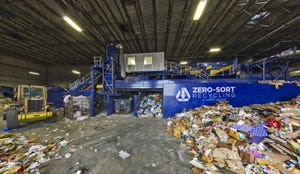MOVING AND SHAKING
October 1, 2005
Michael R. Taylor
WHILE THEY SPECIALIZE in carting debris away, construction and demolition (C&D) debris recyclers say the industry has nowhere to go but up, thanks to a high level of new construction that is forcing old buildings and houses to be demolished. The rising costs of landfilling waste, stringent new government regulations, tax credits awarded to people who divert materials from landfills, the availability of effective mobile crushing, screening and recycling equipment, and a steadily growing concern for the environment also are contributing to the C&D recycling boom. And the excellent after-market value of many recycled materials, such as steel and lumber, is another big motivator for sorting and processing recyclables.
C&D recycling has become such a big business that many demolition contracting firms are vertically integrated to include recycling as a side business. There are 3,500 C&D recycling facilities nationwide, according to one estimate. It only takes a look at recent legislation to see why the business of C&D recycling is moving uphill.
The Push for Policy
In California for example, Sonoma County requires incoming loads of C&D waste to be inspected. Loads could be turned away unless they already have been sorted for recyclables. Companies that do not comply must pay a 25 percent surcharge to drop off the waste and let the county handle the resorting.
In Ohio, the governor has proposed a big increase in landfill tipping fees from $2 per ton to $4.75 per ton. That is in addition to the fee charged by the landfill operator (an average of $28 per ton in Ohio).
In Illinois, Chicago contractors are required to recycle 25 percent of all C&D debris generated in the city, with the number jumping to 50 percent by 2007. Chicago defines C&D debris as “non-hazardous, non-contaminated solid waste resulting from construction, renovation and demolition projects.”
In Oregon, the city of Portland requires a 75 percent recycling rate on all C&D projects exceeding $50,000. More specifically, all land-clearing debris, corrugated cardboard, metals, concrete and asphalt must be recycled within the metro area. A $35 per ton tax is imposed on all landfilled debris, in addition to the $22 per ton tipping fee. Waste Management Inc., Houston, has opened a Portland MRF to achieve the 75 percent diversion requirements placed on its C&D drop box service.
The last U.S. Environmental Protection Agency (EPA) study of C&D debris estimated that 70 percent of the more than 135 million tons of waste comes from demolition projects. A sizeable portion of demolition debris — estimated to be 40 percent — already is being recycled by demolition contractors.
Some contractors routinely achieve 80 to 90 percent recycling rates. However, the National Demolition Association (NDA), the North American trade organization representing companies involved in the demolition process, wants to see a substantial growth in the average 40 percent rate. It has called upon the EPA to develop a national C&D recycling policy.
According to NDA, current state regulations pose a number of barriers to C&D recycling efforts. They include:
Excessive fees for permits to operate a C&D recycling facility;
Over-regulation of procedures used at C&D recycling facilities;
Limited opportunities in state purchasing procedures for the reuse of C&D recycled material; and
Unrealistic C&D recycling goals tied to regional or statewide mandates.
Those barriers contribute to the sizable capital investment needed in equipment, land, time, labor and all other cost points, and further make setting up a profit-making C&D recycling venture difficult, NDA says. A national C&D recycling policy, on the other hand, would create an infrastructure that would free-up landfill space and promote the reuse of valuable commodities and good resource stewardship, while sustaining a cleaner environment, the association says.
NDA suggests a national recycling policy include:
National guidelines dealing with the movement of C&D material;
Standards for material quality, thereby increasing commodity marketability;
Research, incentives and development of end-use markets for recycled C&D debris;
Promotion of recycled C&D materials in the marketplace;
National inspection standards for C&D recycling facilities; and
New tax incentives offered by the federal government to end-users of recycled products that would further encourage their use.
NDA says a national C&D recycling policy has potential to help the industry flourish, similar to when President Bill Clinton mandated that the federal government — the largest single buyer of paper in the world — increase its recycled paper use. The pulp and paper industry responded immediately to develop recycling facilities to meet the demand, the association says. Consequently, NDA believes that the federal government could produce a similar substantial increase in the recycling and reuse of C&D material by establishing purchasing guidelines and specifications for C&D.
The NDA has identified 14 major constituents of a structure that can be recycled. The list includes carpet, drywall, glass, ceiling tiles, wood, asphalt roofing shingles, brick, metal and other constituents. Realistically, concrete, metal, high-quality lumber and wood have the best market value. Other items with a decent after-market include asphalt, brick and architectural features, such as door, windows, and plumbing and electrical fixtures. The relatively low value of the other constituents can deter contractors from recycling. Drywall can be recycled and is recycled regularly in Europe. However, issues such as the age of the drywall that may contain asbestos and whether drywall was painted (it could have been painted with lead paint) make recycling drywall somewhat unfeasible.
State Survey
Within the past year, the New Jersey Department of Environmental Protection (DEP) released a survey that showed builders and contractors saved money by recycling C&D waste, while providing environmental benefits. “When builders and demolition contractors recycle, they not only lower their operating costs, but also conserve natural resources and reduce demand for landfill capacity,” DEP Commissioner Bradley M. Campbell says.
The New Jersey DEP survey indicated that the average cost to recycle construction material, such as concrete rubble, is $4.85 per ton, versus an average of $75 per ton to landfill the material. There are similar cost savings by recycling other materials, including asphalt at $5.70 per ton and bricks and block at $5.49 per ton. Recycling scrap wood costs $46.43 per ton compared to the $75 average disposal cost. By comparison, it costs $10.75 per ton in Oregon and Washington, which recycle C&D. Large-dimension lumber actually provides a net profit to a demolition job in those states, the study indicated.
According to NDA, C&D recycling makes sense — both financially and environmentally. Take Eugene, Ore.-based Staton Companies as an example. The company is known for its 99 percent recycling rate on projects — for a profit. Whether it is removing a university residence hall or a chipping mill with straightforward or complicated demolition methods, it achieves near-perfect recycling rates.
Cutting out the Waste
When demolishing a residence hall at Oregon Health Science University (OHSU), for instance, Staton Companies developed a simple but elegant demolition plan. The residence hall was built in the 1970s and was a post-tension, lift-slab building that needed to be removed to make way for planned expansion of the OHSU facilities.
Staton Companies completed the $174,000 project in six weeks — including cleanup — using a simple wrecking ball. Asbestos and other hazardous materials had been removed by another subcontractor prior to Staton's arrival, so Staton was able to recycle most of the debris. The company trucked 7,000 tons of concrete to a crusher for recycling. Additionally, 400 tons of scrap metal, 4 tons of aluminum, and 5 tons of copper wire were recovered. Only 10 tons of asphalt roofing material and 20 tons of general demolition debris were landfilled.
At a $1.1 million demolition project in Camas, Wash., the company was equally successful. Georgia Pacific's Camas site is a pulp and paper manufacturing complex bound on three sides by the city of Camas. A little over a quarter of the mill site lies on the north bank of the Camas Slough, which is an arm of the Columbia River. Although the complex still produces paper towels and tissues and pulp, Georgia Pacific contracted Staton to remove a mothballed chipping mill. The old mill occupied space now used as a truck staging area.
“The water on one side and a 72-inch conveyer that runs right next to the building on the other side made Camas a tough job,” Pingel said.
Before demolition began, the company removed 20 tons of electrical motors and pumps and recycled much of the oils from the equipment. Then a subcontractor took down and landfilled 200 tons of asbestos siding. Finally, Staton used one high reach and two standard excavators to shear the 90,000-square-foot steel structure apart.
Pingel estimates that, including the asbestos abatement, the four-month project required approximately 5,000 man-hours. Although 80 tons of demolition debris and 200 tons of asbestos were landfilled, 350 tons of clean, recyclable wood were recovered. When added to the 20 tons of nonferrous metals, 2,500 tons of concrete, and 4,000 tons of scrap metal that were recycled, more than 96 percent of the demolition debris made it way into recycled, reusable products.
Companies like Staton are proving it pays to recycle C&D. If the government and industry together put their full weight of support, the industry will grow even more and become more sophisticated, NDA says.
Michael R. Taylor is executive director of the National Demolition Association. Web site: www.demolitionassociation.com.
THE C&D RECYCLING BOOM
Among the forces affecting the growth of the C&D recycling industry are:
Landfill costs continue to rise.
Local and state governments are demanding a certain percentage of C&D waste recycling.
Mobile crushing and screening equipment is enabling demolition contractors to quickly process waste.
Public awareness of the need to preserve the environment continues to grow.
New construction and related demolition projects are generating a high level of waste.
More government projects are in the works.
It is in the economic interest of demolition contractors to maximize recycling. — MT
You May Also Like


